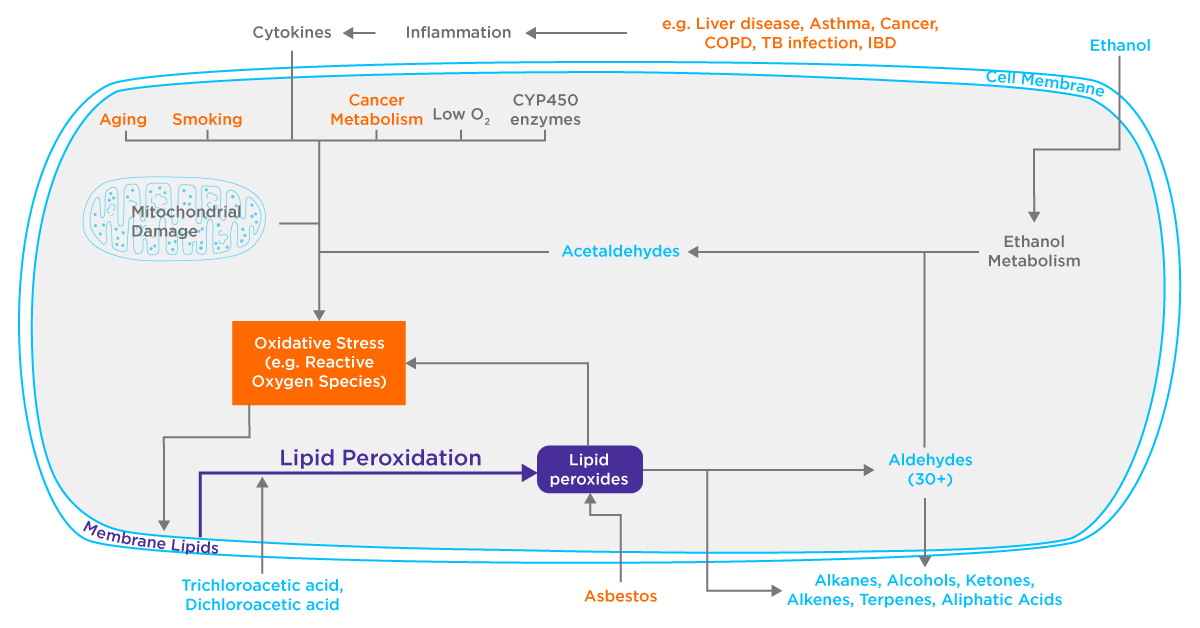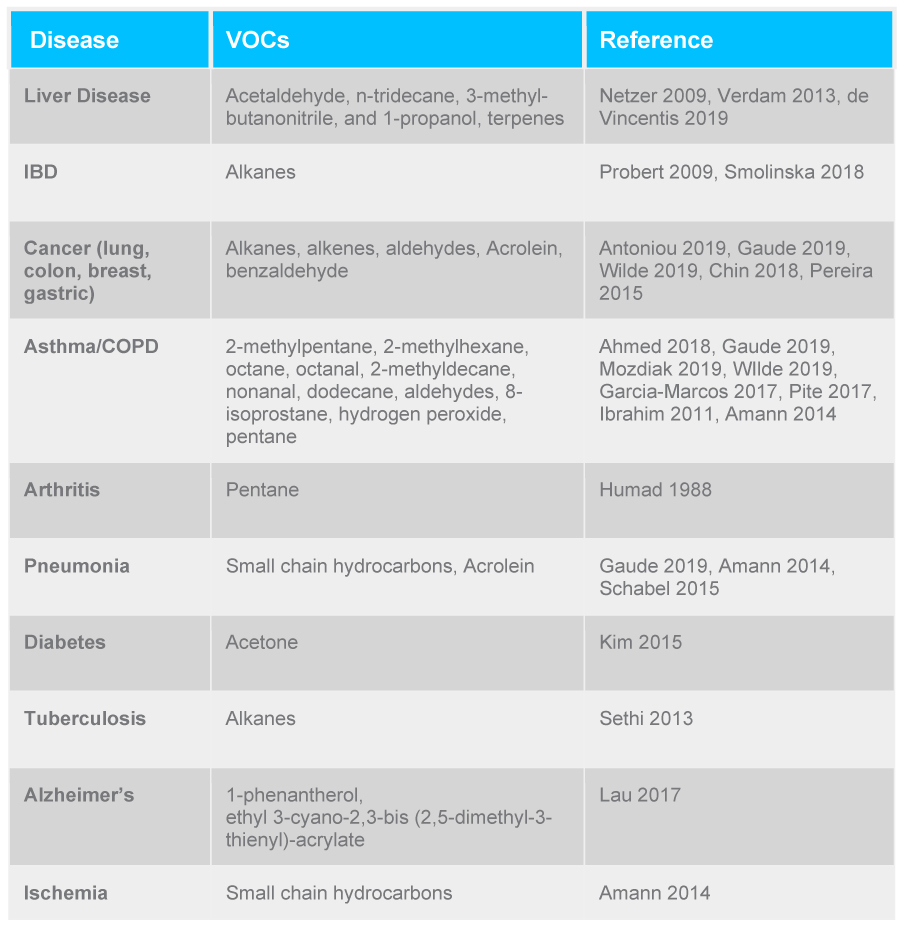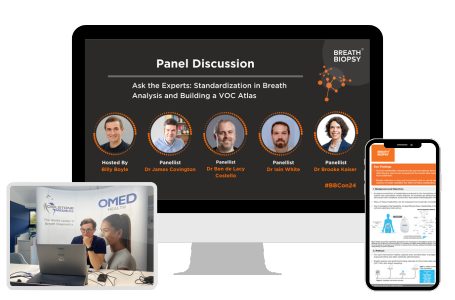Lipid peroxidation as a source of biomarkers in exhaled breath
Published on: 18 Aug 2020
The collection and analysis of exhaled breath can be a rich source of information relevant to health and disease. Many volatile chemicals (known as volatile organic compounds, or “VOCs”) have been detected in the breath and studies have shown that these can be related to the onset, progression, and treatment of a wide range of diseases. As such, compounds in the breath can serve as biomarkers, and breath analysis has many potential applications in early detection and precision medicine.
VOCs in exhaled breath have many origins, both from within the body (endogenous) and inhaled from outside the body (exogenous). Many metabolic processes produce VOCs, and these are thought to be the primary source of endogenous VOCs in breath. However, the evidence linking specific metabolic processes in the body to levels of VOCs detectable in exhaled breath is still limited (1). One metabolic process in the body that is relevant for a number of disease contexts, and is often proposed as a source of exhaled VOCs is lipid peroxidation.
What is lipid peroxidation?
Lipid peroxidation is a result of oxidative stress within cells, which can be caused by disease processes or immune responses such as inflammation (2). Our body has an intrinsic anti-oxidant defense, which normally protects us from the effects of damaging chemicals known as reactive oxygen species (ROS). In stressed cells, a relative lack of antioxidant defense leads to an increase in ROS which can indiscriminately attack other components of the cell including DNA, proteins, and lipids. Lipid peroxidation is a chemical chain reaction between ROS and unsaturated fatty acids that results in the production of VOCs (3). There is significant interest in discovering biomarkers for oxidative stress as it is thought to play a major role in the development of many illnesses. As such, exhaled VOCs associated with lipid peroxidation have many potential applications to serve as informative biomarkers.

Lipid peroxidation typically produces linear or branched VOCs, with aldehydes being one of the most common products. Often these aldehydes are reduced by enzymes, resulting in alcohols, alkanes, and other organic compounds (1,4). The specific compounds produced depend on the structure of the fatty acids involved. Numerous papers in the breath research field suggest lipid peroxidation as a theoretical source for candidate biomarkers, this has been seen repeatedly in a number of major areas including respiratory diseases, liver diseases, and cancer.

Linking lipid peroxidation and exhaled VOCs
VOC Biomarkers have been investigated in respiratory conditions including asthma, COPD, and lung cancer. These conditions often share similar inflammatory responses, of which lipid peroxidation is a known component that could contribute to elevated levels of hydrocarbon VOCs (5), particularly aldehydes (6). In cancers, both in the lung (7,8,9) and elsewhere, accumulated oncogenic mutations and high metabolic demand often lead to oxidative stress. In fact, pentane was one of the first breath biomarkers reported for breast cancer (10). The connection between cancer biology and VOCs from lipid peroxidation was recently illustrated further through an in vitro study of cultured cells (11).
In a previous blog, we reviewed VOCs associated with fatty liver diseases and cirrhosis where several studies have suggested associations with lipid peroxidation (12,13). Exhaled VOCs linked to lipid peroxidation have been seen in other conditions too including heart transplant rejection (14,15,16), mesothelioma (17), angina (18), Crohn’s disease, and ulcerative colitis (19,20). Table 1 summarizes further VOCs with proposed links to lipid peroxidation that have been identified in various disease contexts.

While lipid peroxidation appears to contribute to exhaled VOC profiles in many diseases, it is interesting to note that the specific VOCs involved seem to vary by context. This effect may be due to the different lipid compositions and redox enzyme complements of different cell types, resulting in a more unique set of VOC products.
Towards biomarker panels for oxidative stress
Despite the richness of publications proposing lipid peroxidation as a source of exhaled VOCs, further work is still needed to conclusively demonstrate the connection between biological processes and VOC emissions. We are conducting ongoing research to specifically identify the VOC products produced as a result of lipid peroxidation of various fatty acids in vitro. This represents a key step towards demonstrating specific VOCs produced through lipid peroxidation, and we hope to conclusively associate different fatty acids with distinct sets of VOC profiles in the breath.
Biomarker research demonstrating the biological origins of prospective breath compounds identified through in vivo clinical studies has been limited. More recently, VOC emissions from in vitro cell lines have been used to help develop the link between cell metabolism and VOCs detected in breath and other sampling media (1,11). Our in vitro capabilities mean that we can support you in both discovering and validating biomarkers detected in exhaled breath as well as performing in vitro studies to investigate the mechanistic origins of your VOCs of interest.
Get in touch to discuss how we can support your research through the identification and analysis of VOCs both in vivo, and in vitro.
References
- Filipiak et al. A Compendium of Volatile Organic Compounds (VOCs) Released By Human Cell Lines, Curr Med Chem. 2016, DOI: 10.2174/0929867323666160510122913
- Zanella et al. Comparison of the effect of chemically and biologically induced inflammation on the volatile metabolite production of lung epithelial cells by GC×GC-TOFMS, Analyst. 2020, DOI: 10.1039/d0an00720j
- Ratcliffe et al. A mechanistic study and review of volatile products from peroxidation of unsaturated fatty acids: an aid to understanding the origins of volatile organic compounds from the human body, J Breath Res. 2020, DOI: 10.1088/1752-7163/ab7f9d
- Calenic et al. Oxidative stress and volatile organic compounds: interplay in pulmonary, cardio-vascular, digestive tract systems and cancer, Open Chem. 2015, DOI: 10.1515/chem-2015-0105
- Van de Kant et al. Clinical use of exhaled volatile organic compounds in pulmonary diseases: a systematic review, Respir. Res. 2012, DOI: 10.1186/1465-9921-13-117
- Corradi et al. Aldehydes in Exhaled Breath Condensate of Patients with Chronic Obstructive Pulmonary Disease, Am J Respir Crit Care Med. 2002, DOI: 10.1164/rccm.200210-1253OC
- Mazzone, Analysis of Volatile Organic Compounds in the Exhaled Breath for the Diagnosis of Lung Cancer, J Thoracic Onc. 2008, DOI: 10.1097/JTO.0b013e31817c7439
- Poli et al. Determination of aldehydes in exhaled breath of patients with lung cancer by means of on-fiber-derivatisation SPME–GC/MS, J Chromat B. 2010, DOI: 10.1016/j.jchromb.2010.01.022
- Liu, Li and Duan, Effect of H2O2 induced oxidative stress (OS) on volatile organic compounds (VOCs) and intracellular metabolism in MCF-7 breast cancer cells, J Breath Res. 2019, DOI: 10.1088/1752-7163/ab14a5
- Hietanen et al. Diet and oxidative stress in breast, colon and prostate cancer patients: a case-control study, Eur J Clin Nutr, 1994. https://pubmed.ncbi.nlm.nih.gov/7957003/
- Furuhashi et al. Elucidation of Biochemical Pathways Underlying VOCs Production in A549 Cells, Front Mol Biosci. 2020, DOI: 10.3389/fmolb.2020.00116
- Hanouneh et al. The Breathprints in Patients With Liver Disease Identify Novel Breath Biomarkers in Alcoholic Hepatitis, Clin Gastrol Hepatol. 2014, DOI: 10.1016/j.cgh.2013.08.048
- Duchatelle et al. Increased ethane exhalation, an in vivo index of lipid peroxidation, in alcohol-abusers, Gut. 1993, DOI: 10.1136/gut.34.3.409
- Sobotka et al. Breath pentane is a marker of acute cardiac allograft rejection. J Heart Lung Transplant, 1994 https://pubmed.ncbi.nlm.nih.gov/8031804/
- Phillips et al. Heart allograft rejection: detection with breath alkanes in low levels (the HARDBALL study). J Heart Lung Transplant, 2004, DOI: 10.1016/j.healun.2003.07.017
- Gaude et al. Targeted breath analysis: exogenous volatile organic compounds (EVOC) as metabolic pathway-specific probes. J Breath Res. 2019, DOI: 10.1088/1752-7163/ab1789
- Lamote et al. Exhaled breath to screen for malignant pleural mesothelioma: a validation study. Eur Respir J. 2017, DOI: 10.1183/13993003.00919-2017
- Phillips et al. Breath markers of oxidative stress in patients with unstable angina. Heart Dis. 2003, DOI: 10.1097/01.hdx.0000061701.99611.e8
- Pelli et al. Breath alkanes determination in ulcerative colitis and Crohn’s disease. Dis Colon Rect. 1999, DOI: 10.1007/BF02235186
- Sedghi et al. Elevated breath ethane levels in active ulcerative colitis: evidence for excessive lipid peroxidation. Am J Gastroenterol. 1994 https://pubmed.ncbi.nlm.nih.gov/7977245/
Catch up on the presentations from the Breath Biopsy Conference 2024
